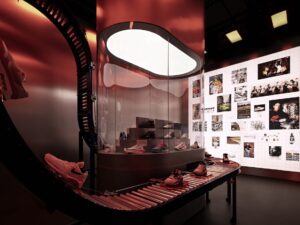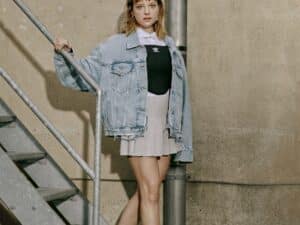A review of Johanna Hedva’s exhibition God is an Asphyxiating Black Sauce
HOW TO GIVE BIRTH TO GOD
I wish I could write a paragraph as a body sculpture, or simply a pose, to describe the God is an Asphyxiating Black Sauce exhibition. I could describe it as sitting in a decent hell: I wish I was able to show through words even one isolated moment of sitting there in the Klosterruine, listening to one of the tracks in the Playlist to the Void. My words fall short, as if dropped from a plane down into the Atlantic, faced with the sharpness of Hedva’s words, to all the dimensions where their sound spreads; to describe their mystical realness. But then, writing into the lack of one’s words might be the most appropriate way to try to talk about Johanna Hedva’s work. Rather than an exhibition review, I want to write a dispatch of love.
A month ago, the Korean-American artist, writer, and musician Johanna Hedva opened their exhibition titled God is an Asphyxiating Black Sauce. It can be visited at Klosterruine, the Gothic monastery ruins in Mitte, and online at http://godsauce.black/, a website designed by Universal Solvent Studios. Additionally, it stretches out as posters, featuring graphics by architect Johannes Beck, distributed throughout the city of Berlin. The exhibition is on view until August 3rd. It is curated by Christopher Weickenmeier, introducing his planned two-years investigations into time as the new director of Klosterruine. Alongside Hedva’s work from the past ten years, the central piece of the exhibition, Playlist to the Void, features tracks by Pauline Lay & Gabie Strong, William Fowler Collins, Geneva Skeen, and Anja Kangiesser.
Perhaps you know Johanna Hedva’s sound work from when they were a resident at Amplify Berlin at Acud Macht Neu in November. Maybe you have come across their writing on accessibility and the often quoted Sick Woman Manifesto. Maybe you were lucky to see them perform a drony, noise guitar opus/ritual Black Moon Lilith in Pisces in the 4th House. Or perhaps you are familiar enough to have flipped their book On Hell. But if the God is an Asphyxiating Black Sauce exhibit is your first encounter with Hedva’s work, I imagine it as an excellent place to start.
I envision Johanna Hedva as a meteorite: made up of some condensed unrealness as well as the heaviest of materiality at the same time. In the book My Meteorite (the brilliant confessional of attempting to relate), the artist Harry Dodge describes the way he keeps waiting for his purchased space rock to melt through him, into the core of the Earth, and then all the way back through the Universe at any given moment. Sitting with Hedva’s work wrapping around me in Klosterruine, the space they created with their sound, the space they created by the speakers, benches, and ramps being the only objects installed inside the ceilingless brick walls of the former monastery, felt the same. Once, I heard quantum particles constantly appear and disappear, that they can pass through barriers. Yet they are also the foundation of all materiality. This makes no “rational” sense to the little I know about physics, but it makes a lot of sense with my experiential knowledge of the world, which is also myself, which is also god, which is also nothing, which is also time. Permeability, the arrangement of nothings, being the basis of stuff, resonates within the exhibition, the goal being to investigate the “matters of accessibility to be the very condition of any meaningful exploration of absence(s)…”, …I think…
The exhibition permeates many planes: the sound at the physical site leaks through the non-existing roof and glassless windows into its surroundings, the posters with quotes from Hedva’s upcoming book Minerva the Miscarriage of Brain pop up around the city, the digital presence brings the livestream of the sky above Klosterruine as well as the central playlist online. In turn, the project is set up to be penetrated. It sucks in exterior concepts, the sounds of Mitte, its poster paper is torn by the weather, it is dusted on by digital bits. It moves between different times, bringing up encounters with Greek myths, god, goddesses, the moon turn into guitar noise music, for instance. It abolishes the capitalist time that forces production, filling, linear progress. It is cosmic. And to witness this- to even become a part of this- is pure pleasure.
There are fancy words that can be woven around this exhibit, but they should not hide the fact that Johanna Hedva’s god sauce is a manifestation of alliances to people, of topics, and for places. It is a very real resistance. I hope the care invested in accessibility of this project marks a tradition for Klosterruine and serves as an inspiration for other Berlin art spaces. One of the running themes of her work, the exclusion and choking of ableism, is also a call from/for a different key to being in the world. Timothy Morton says: “To be a thing at all is to have been hurt… The universe itself might be bruised from some unimaginable ancient bubble collision with another universe.” Johanna Hedva’s universe is most definitely hurt. But it is not bruised as broken, nor is it less than perfect. Hedva’s hurt now serves as a basis for relating one to another. After all, there are only two constants: death, and the fact that at one point or another, we will all be sick.
Text by Magdalena J. Härtelova
Artwork imagery courtesy of Juan Saez, Klosterruine Berlin
Portrait of the artist by Ian Byers-Gamber



